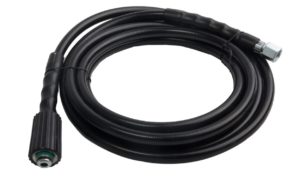 Are you suffering from a problem with pressure washers? But don’t know what happened to the pressure washer hose and how to repair it? If this is your case, this article will solve your problem. Pressure washers are powerful cleaning machines that remove heavy stains with high-pressure water streams. The internal surface of the pressure washer hose bears enormous pressure that is about 10 to 15 times more than the standard garden hose maximum pressure limit. If the pressure washer hose leaks at that pressure, it can be dangerous because any leak would eventually result in total pressure loss that diminishes the idea of pressure cleaning.
Are you suffering from a problem with pressure washers? But don’t know what happened to the pressure washer hose and how to repair it? If this is your case, this article will solve your problem. Pressure washers are powerful cleaning machines that remove heavy stains with high-pressure water streams. The internal surface of the pressure washer hose bears enormous pressure that is about 10 to 15 times more than the standard garden hose maximum pressure limit. If the pressure washer hose leaks at that pressure, it can be dangerous because any leak would eventually result in total pressure loss that diminishes the idea of pressure cleaning.
Moreover, this unexpected leakage causes injury or damage too. Thus, repairing a leaking pressure washer hose is not similar to traditional garden hose patching because of the high pressure. Here, we are going to discuss the repairing of the high-pressure hose. So let’s begin.
Repairing the High-Pressure Hose | Step by Step Guide
The high-pressure hose is the end of the pressure that connects the spray wand and the water outlet of the pressure washer. If any leaks or damage are observed in a high-pressure hose, the best practice is to replace the hose completely. It is not similar to repairing a regular hose that you can quickly repair with epoxy, tape, or other methods. However, if you think that the leak is not too significant and can be improved, it is best to repair it by cutting the leakage area and replacing it with a new coupling.
- First of all, when you detect any leaks, turn off the pressure washer immediately and disconnect it from the power source if it is an electric pressure washer.
- Now remove any water from the pressure washer by disconnecting the garden hose and pressing the trigger to release any pressure build-up.
- Detach the high-pressure hose from the pressure washer if applicable. Now locate the leak on the pressure washer. It is better to mark it with chalk or some other marker so that you do not lose it. Make sure that you point out all the leaks or punctures if there is more than one.
- Cut the hose from the side of the leaks. If the leaks are near one another, you can merge them in one cut. Make sure that the cuts are clean and straight across the cross-section. It is better to use a pair of shears or some sharp blade to cut the hose.
- Now insert the positive repair coupling into one end of the hose. Make sure that the coupling is in a suitable size.
- Crimp the end of the couplings so that they are adequately tightened in the hose. Make sure that you make all the connections secure.
- Insert the negative repair coupling on the other side of the hose. Crime ends in the same way as the previous crimp. It is better to tighten the joints with the compression rings to secure them.
- Connect positive and negative coupling together and pull them with the use of a wrench.
- Use the Teflon tape on the coupling to avoid any possible leaks.
Now that you have repaired the leaks, it is time to connect the high-pressure hose and test it. Ensure that you use the pressure washer on the lowest settings if there is an unloading valve. Make sure that the hose is not leaking from anywhere. When you have made sure that it is not leaking, you are clear to use the pressure washer as usual.
Although it is not as simple as the duct tape or epoxy repairing the hose, this method is used to improve the leaks of the high-pressure hose. Coupling is the best and only method that can bear high pressure.
Final Thoughts
Repairing the high-pressure hose is not like reaping any other ordinary hose because it has to bear the pressure 10 to 15 more than others. The only method to repair the leaks is by coupling, which includes cutting the leaked part of the pressure hose. This method is very costly compared to the other methods but still has a significant advantage compared to replacing the whole high-pressure hose. Using the leaked pressure hose can cause the pressure to drop at the end, and if not repaired on time, it can get worse, destroying the whole pipe.
- 10 Best Budget Pressure Washer 2023 – Reviews & Buyer’s Guide - December 7, 2022
- 10 Best Pressure Washer for Cars Wash Reviews [2023] - December 6, 2022
- 10 Best Commercial Pressure Washer 2023 –Buyer’s Guide - December 5, 2022
